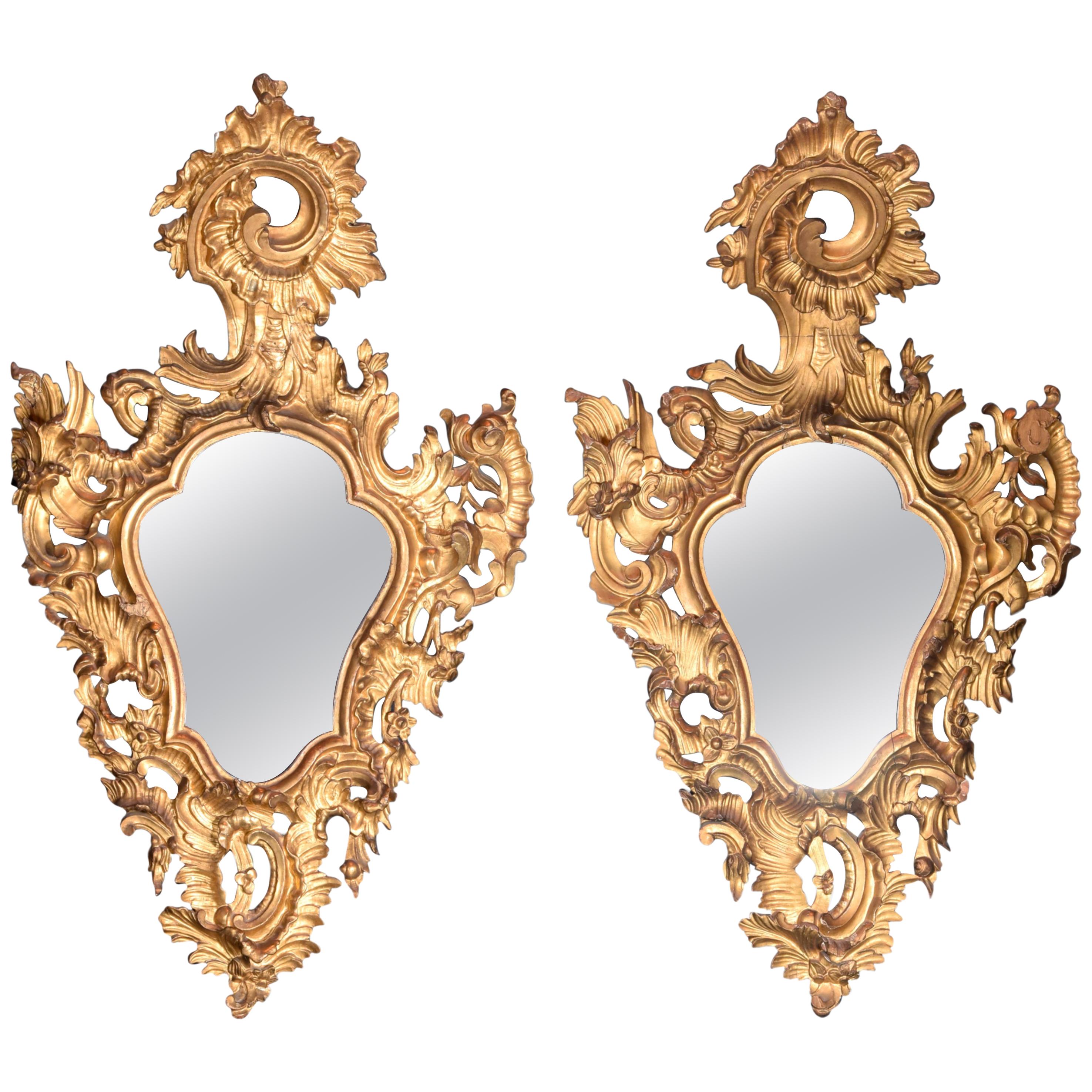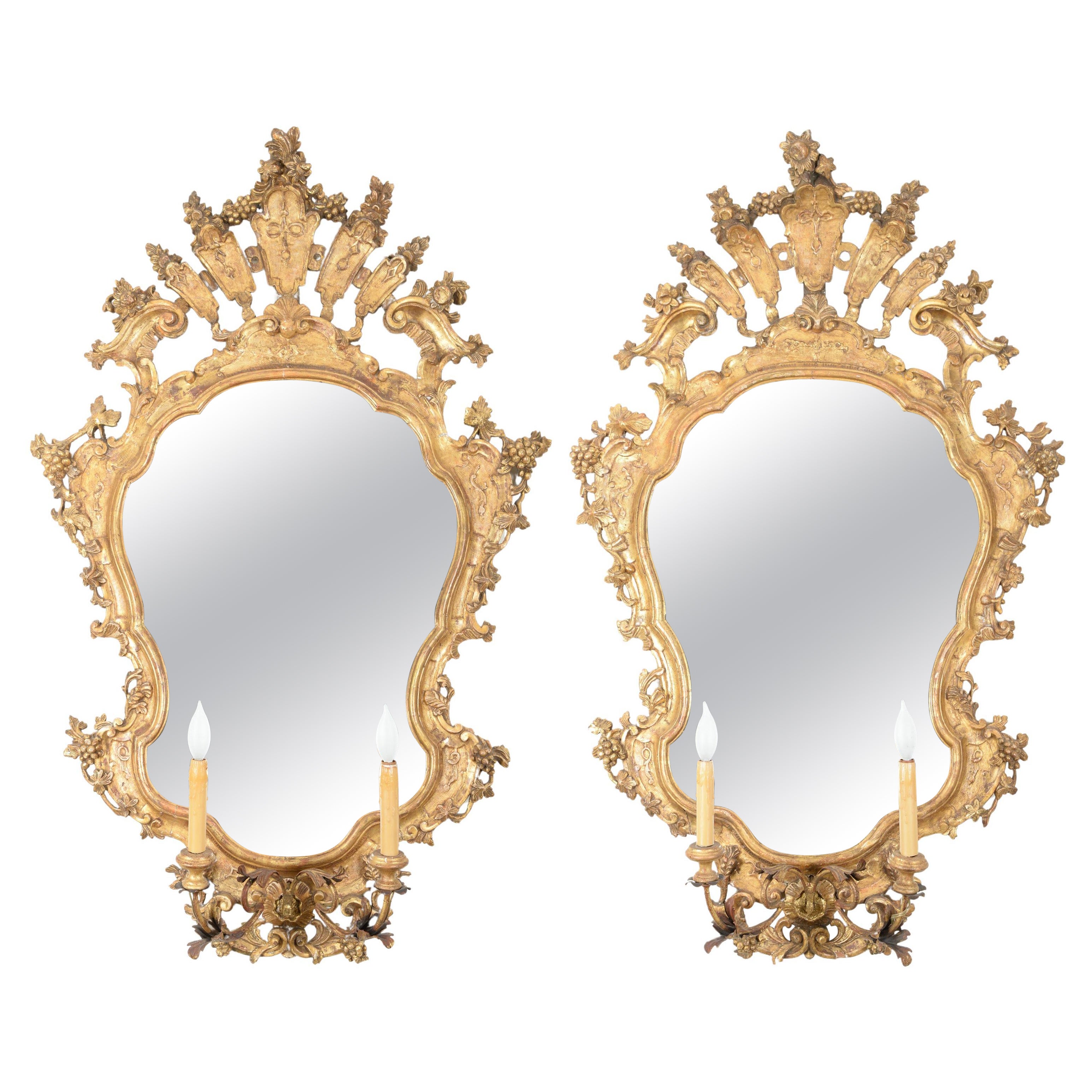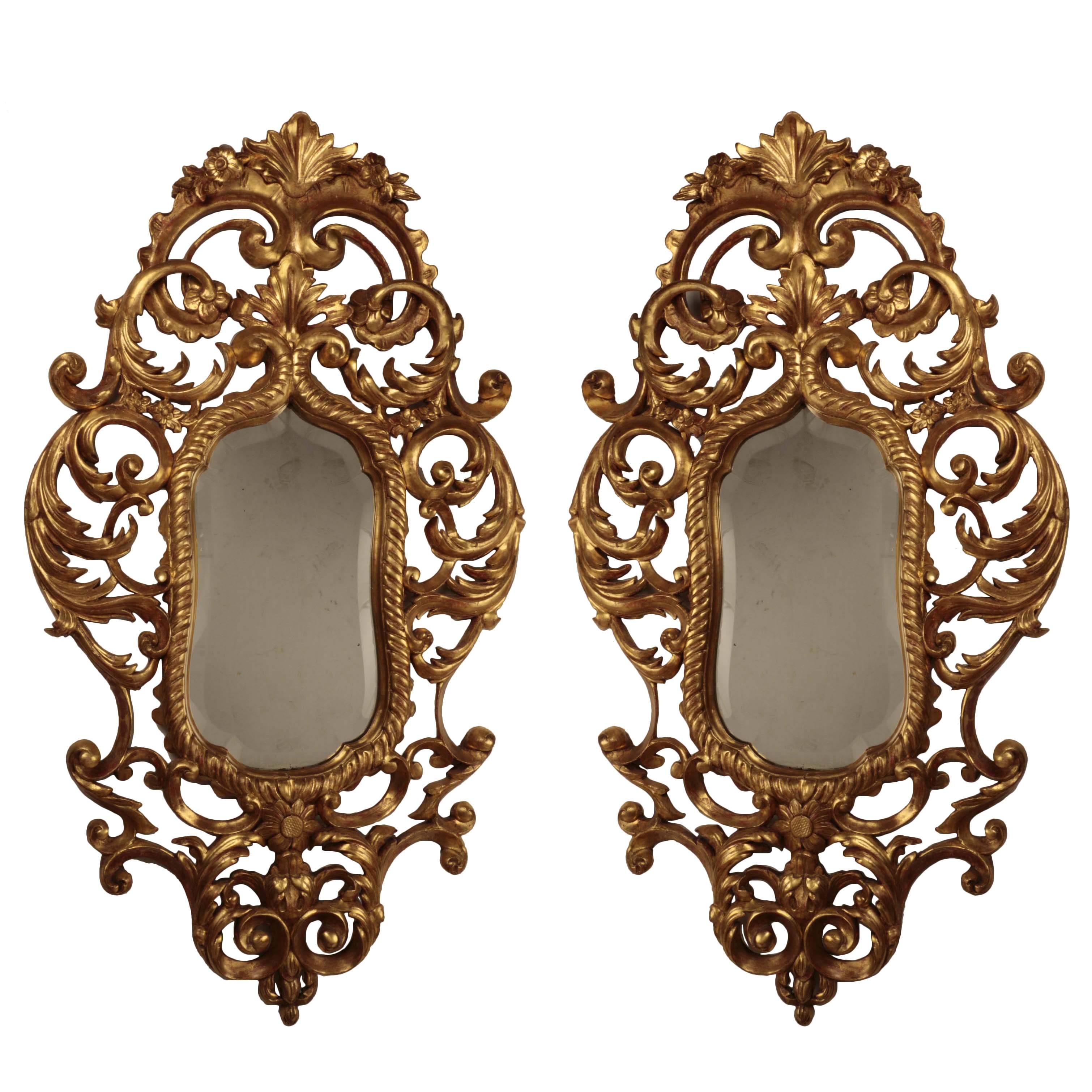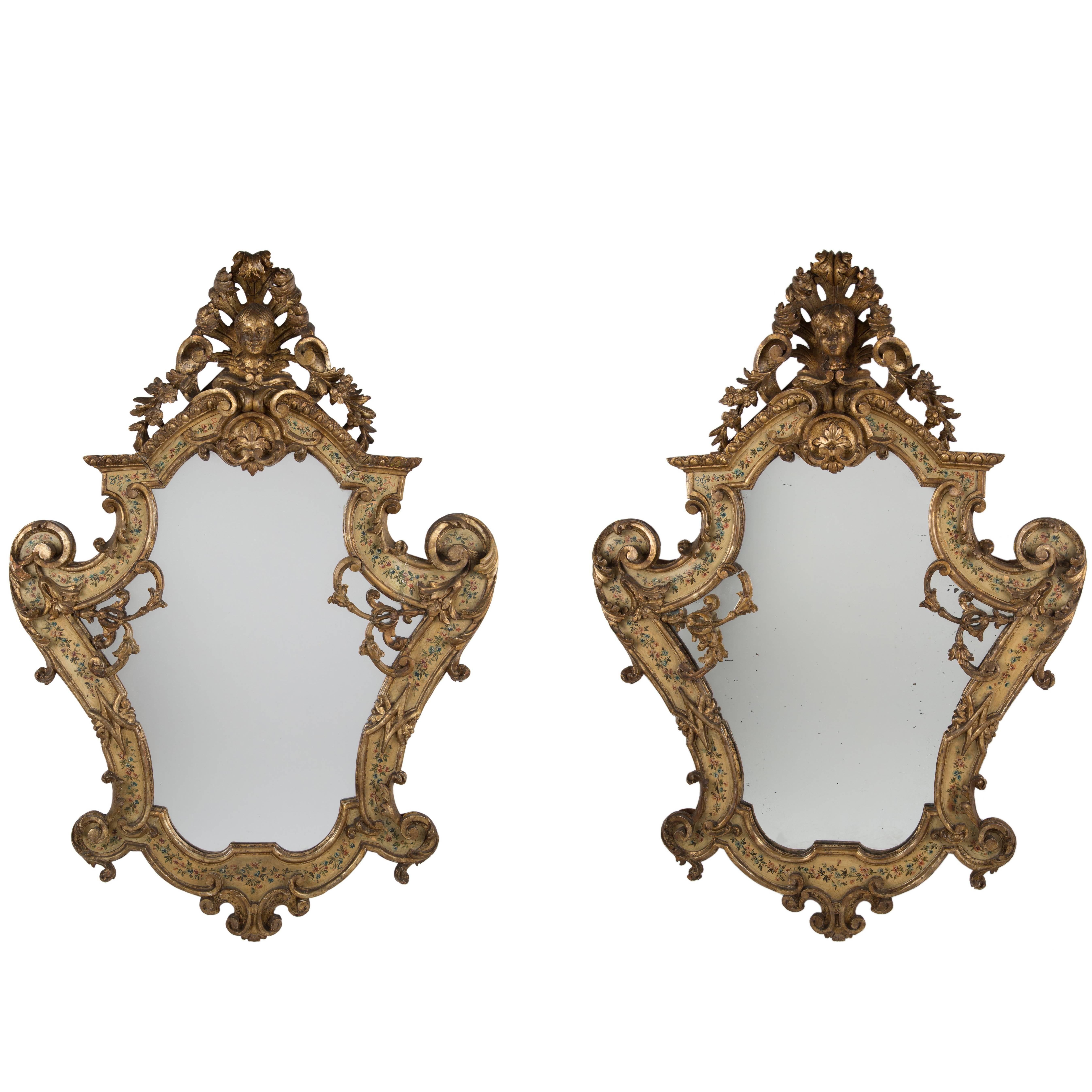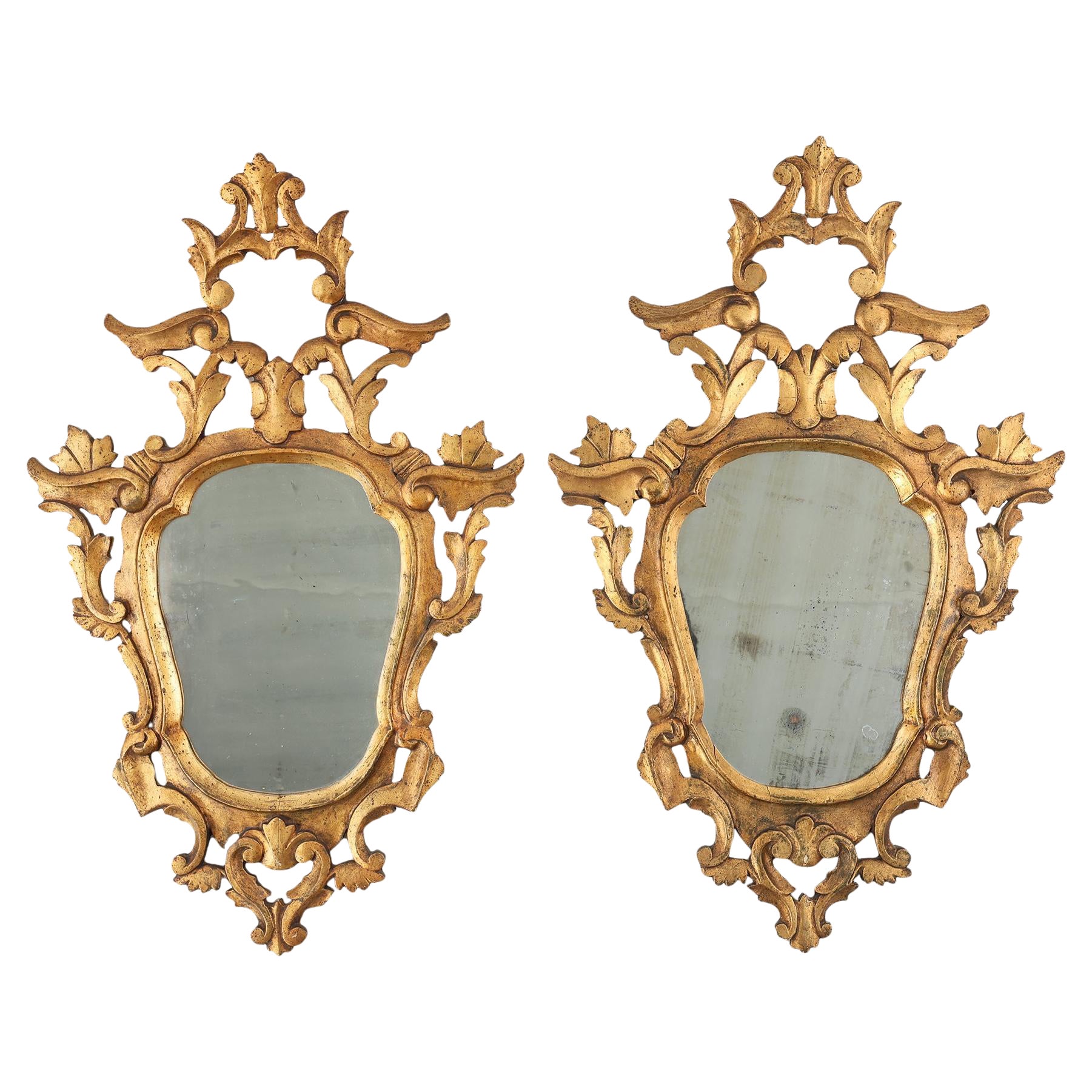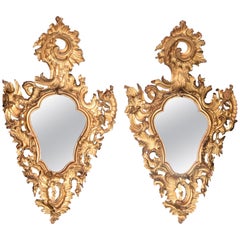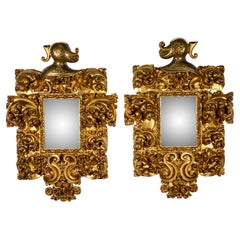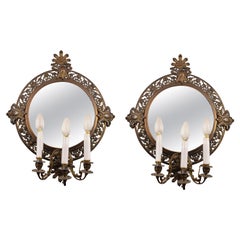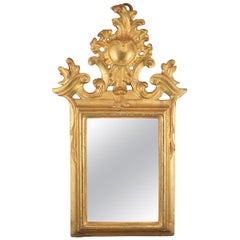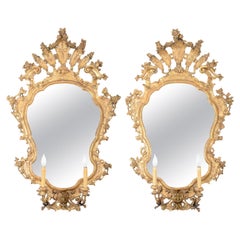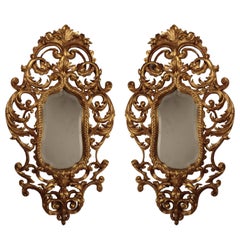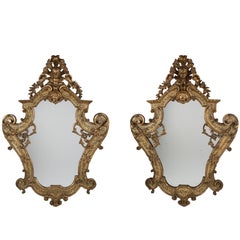Items Similar to Pair of Giltwood Mirrors with Porcelain, Rococo, 18th Century
Want more images or videos?
Request additional images or videos from the seller
1 of 6
Pair of Giltwood Mirrors with Porcelain, Rococo, 18th Century
$22,690.71
£16,779.08
€19,000
CA$31,167.89
A$34,656.91
CHF 18,143.52
MX$423,340.59
NOK 227,991.16
SEK 214,471.37
DKK 144,670.37
About the Item
Pair of "cornucopias" with mirrors, nearly identical (except for details in the leaves of the frames), carved and gilded wood. Inside, the main mirror has moldings that draw curves and straight areas, volutes and other elements. The elaborate decoration of the wall mirrors is based on grotesques in the lower part, from which plant elements emerge that are prolonged, accompanied by hangings, towards the upper part by the sides, with openwork details. Above, the crests have circular spaces, flanked by birds perched with its wings partly extended, and surrounded by elaborate frames that, like the rest of the pieces, have architectural elements (scrolls, smooth oval mirrors), plant elements and shapes that remind Rococo rockery.
Clearly, the examples are included within the Rococo, counting, even with the slight asymmetry presented by the decorative motifs of the same and that slight difference between both examples. It is possible to find similarities in the design of these cornucopias with different engravings and works by Matthias Lock (London, circa 1710-circa 1765). Compare with prints of the work "A New Book of Ornaments with Twelve Leaves Consistint of Chimneys, Sconces, Tables, Spandle Panels, Spring Clock Cases, Stands, Chandelier and Girandole, etc." (Henry Copland and Matthias Lock, London, 1752 ), with examples preserved in the Metropolitan Museum of New York, drawings of the Victoria & Albert Museum in London, etc. Matthias Lock was the first to publish Rococo designs in England, as well as being considered the first to master the Rococo style and include it in his works and designs. Little more is known of his life: he was a pupil of Thomas Chippendale and Adams, perhaps he worked with Henry Copeland and his work derived from the most elaborate Rococo to the most harmonious Classicism.
The small porcelain plates that appear in the upper part show a pheasant located on a rock and between chrysanthemums and other flowers, in a common composition in this type of objects, made in China for export to Europe and, therefore, without having given meaning to any of the animals or plants (the golden pheasant was the Emperor's symbol, and the one in this dish has no yellow in its plumage). Chinese porcelain was already known in Europe in the fifteenth century, but its commercial peak came from the sixteenth, with the well-known Blue and White pieces that even inspired the local pottery of the different kingdoms. As for the so-called "Famille Rose" because of the predominance of this shade in its enamelling, it was born with the introduction of that color in China at the beginning of the 18th century by the Jesuits and it continued with its production until the 19th century. In addition, it became so valued that it displaced the "Famille Verte" in European courts at some moments, with the works of the reigns of the Yongzhen (1678-1735) and Qianlong (1711-1799) Emperors as the most abundant and much appreciated and sought after for its great quality. Stylistically, these two plates inserted in the mirrors are very similar to works of the "Famille Rose" made at the end of the reign of Emperor Yongzheng or early Qianlong in Kingdezhen (Jiangxi, Republic of China) towards, approximately, 1735. In fact, there are some dishes in private collections with pheasants in the same position on a stone practically equal to that of these two examples. Note that you can see the decorated border of the same, hidden almost entirely by the wood.
Size: 100 x 68 x 12 cm.
- Similar to:Matthias Lock (Manufacturer)
- Dimensions:Height: 39.38 in (100 cm)Width: 26.78 in (68 cm)Depth: 4.73 in (12 cm)
- Style:Rococo (Of the Period)
- Materials and Techniques:
- Place of Origin:
- Period:
- Date of Manufacture:18th Century
- Condition:Wear consistent with age and use. Minor losses. Minor structural damages. Minor fading.
- Seller Location:Madrid, ES
- Reference Number:Seller: Z66381stDibs: LU295139244453
About the Seller
4.9
Vetted Professional Seller
Every seller passes strict standards for authenticity and reliability
Established in 1985
1stDibs seller since 2017
349 sales on 1stDibs
Typical response time: 17 hours
- ShippingRetrieving quote...Shipping from: MADRID, Spain
- Return Policy
Authenticity Guarantee
In the unlikely event there’s an issue with an item’s authenticity, contact us within 1 year for a full refund. DetailsMoney-Back Guarantee
If your item is not as described, is damaged in transit, or does not arrive, contact us within 7 days for a full refund. Details24-Hour Cancellation
You have a 24-hour grace period in which to reconsider your purchase, with no questions asked.Vetted Professional Sellers
Our world-class sellers must adhere to strict standards for service and quality, maintaining the integrity of our listings.Price-Match Guarantee
If you find that a seller listed the same item for a lower price elsewhere, we’ll match it.Trusted Global Delivery
Our best-in-class carrier network provides specialized shipping options worldwide, including custom delivery.More From This Seller
View AllPair of Ornamental Mirrors, Giltwood, Roccoco, 18th Century
Located in Madrid, ES
This type of works were only made for main houses, since their main use was to reflect the light of candles and lamps in these luxurious interiors, also showing the economic power of...
Category
Antique 18th Century European Rococo Wall Mirrors
Materials
Other
Pair of mirrors. Carved and polychrome wood. Spanish School, 17th century.
Located in Madrid, ES
Pair of mirrors. Carved and polychrome wood. Spanish School, 17th century.
Pair of wall mirrors, each with a rectangular frame and a prominent frame made of carved, polychrome, and gilded wood. These elements are arranged symmetrically, divided into two areas: a thin band with leaves on the inside and a wider one on the outside, with scrolls, acanthus leaves, volutes on the outside, protrusions on the sides, a finial at the bottom, and a helmet-shaped crown, more heraldic than royal due to its details. This one has also been decorated with lines of pearls and an elaborate composition based on simplified plant motifs on a dark background, recalling the bluing common on this type of piece when they were made of metal and royal. One of the helmets faces right, the other left. This crest features a neck guard and a single-piece neck guard, a lowered visor ending in a point, a nape of the neck (which would have been used to accommodate a crest or crest), and, despite not having a wreath, its features are what separate it from royal closed helmets, helms, bascinet, and snouts. Compare, for example, with the Italian cuirassier helmet...
Category
Antique 17th Century European Baroque Wall Mirrors
Materials
Other
Pair of mirrors with appliqués. Metal, glass. 20th century.
Located in Madrid, ES
Pair of mirrors with appliqués. Metal, glass. 20th century.
Pair of wall mirrors with metal frames, decorated with architectural and plan...
Category
20th Century European Other Wall Mirrors
Materials
Metal, Other
Ornamental Mirror Frame, Giltwood, 18th Century
Located in Madrid, ES
It requires restoration.
Rectangular cornucopia with carved and gilded wooden frame decorated with a series of smooth moldings and with a very elaborate finish on the upper part (ar...
Category
Antique 18th Century European Rococo Picture Frames
Materials
Metal
Ornamental Mirror, 20th Century
Located in Madrid, ES
Rectangular mirror with wide frame, formed by wings, crest and lower back with decorative motifs inspired by the classic tradition (scrolls, vases, garlands, etc.). It is inspired by...
Category
20th Century European Rococo Revival Wall Mirrors
Materials
Wood
Mirror with Rococo Style Frame, Wood, 20th Century
Located in Madrid, ES
Mirror with gilt wood trim. Twentieth century.
Rectangular mirror highlighted by a decoration based on carved plant elements and a motif of bars in a plant form. The curves that the...
Category
20th Century Spanish Rococo Revival Wall Mirrors
Materials
Wood
You May Also Like
Pair of 18th Century North Italian Rococo Giltwood Mirrors
Located in Berlin, DE
A pair of 18th century North Italian giltwood mirrors and former girandoles or sconces. Elaborately carved in symmetrical form with flowers, leaves, Ho Ho Birds, scrollwork and rocailles. A metal mount for the candle branches still attached at the bottom of the mirror. The mirror used...
Category
Antique 18th Century Italian Rococo Wall Mirrors
Materials
Mirror, Giltwood
Pair of Large Italian Rococo Giltwood Mirrors (Girandoles)
Located in Kittery Point, ME
Pair of Roman Rococo Giltwood Mirrors (Girandoles), each shaped plate within a cartouche-shaped frame surmounted by a pierced fan-shaped cresting carved with bunches of grapes, flowe...
Category
Antique Mid-18th Century Italian Rococo Wall Mirrors
Materials
Giltwood
Pair of Italian Giltwood Rococo Mirrors
Located in Montreal, QC
We have taken some photos of the backs of both mirrors to try to convey their age . Clearly, they are antique, but they seem to be quite unusual. We can find no other similar pair f...
Category
Antique Early 18th Century Italian Rococo Wall Mirrors
Materials
Mirror, Wood
$12,000 / set
Pair of Venetian Lacca Povera and Polychrome Giltwood Mirrors
Located in New York, NY
Pair of Louis XV carved giltwood polychrome mirrors with figural crown and ornate floral motif. First half, 18th century.
Height 38.5 in.
Category
Antique 18th Century Italian Louis XV Wall Mirrors
Materials
Giltwood, Mercury Glass, Lacquer
Pair of two Venetian Rococo giltwood mirrors, ca. 1850 Italy
Located in Meulebeke, BE
Italy / 1850 / 2 mirrors / wood / Baroque / Rococo / Mid-century
A pair of very fine Italian Rococo carved and gilded wood mirrors with original mirrors and beautiful patina. Carved...
Category
Antique Mid-19th Century Italian Rococo Wall Mirrors
Materials
Mirror, Wood
Antique Pair Florentine Rococo Giltwood Mirrors 19th Century
Located in London, GB
This is a superb pair of antique Italian Florentine giltwood mirrors, circa 1870 in date.
The oval mirrors plates are set within a Rococo boldly-carved scrolling acanthus frame, and they retain the original gilding.
Florentine style refers to the art and architecture coming out of Florence, Italy during the Renaissance period. Florentine furniture is characterized by the heavy use of gold gilding on wood and very elaborate hand carved decoration.
This impressive pair is certain to make a charming addition to that one special room in your home.
Condition:
In excellent condition having been beautifully cleaned and waxed in our workshops, please see photos for confirmation.
Dimensions in cm:
height 102 x width 63 x depth 4
Dimensions in inches:
height 3 foot, 4 inches x width 2 feet, 1 inch x depth 2 inches
Rococo
Although Rococo is usually thought of as developing first in the decorative arts and interior design, its origins lie in the late Baroque architectural work of Borromini (1599–1667) mostly in Rome and Guarini (1624–1683) mostly in Northern Italy but also in Vienna, Prague, Lisbon, and Paris. Italian architects of the late Baroque/early Rococo were wooed to Catholic (Southern) Germany, Bohemia and Austria by local princes, bishops and prince-bishops. Inspired by their example, regional families of Central European builders went further, creating churches and palaces that took the local German Baroque style to the greatest heights of Rococo elaboration and sensation.
An exotic but in some ways more formal type of Rococo appeared in France where Louis XIV's succession brought a change in the court artists and general artistic fashion. By the end of the king's long reign, rich Baroque designs were giving way to lighter elements with more curves and natural patterns. These elements are obvious in the architectural designs of Nicolas Pineau. During the Régence, court life moved away from Versailles...
Category
Antique 1870s Italian Rococo Wall Mirrors
Materials
Mirror, Giltwood
More Ways To Browse
Booker Mirror
Hidden Mirror
Antique Mirror Dining Table
18th Century New England
Rococo Architecture
Rococo Panels
White Wood Wall Panels
Lock Of London
Gilded Table Mirror
Antique Porcelain Mirror
Chinese Wall Scrolls
Export Blue And White 18th Century
Chinese Wood Wall Panel
Antique Wood Book Stand
Antique Wall Hangings
Used Furniture Little Rock
Thomas White Porcelain
Antique Carved Wood Plant Stand

